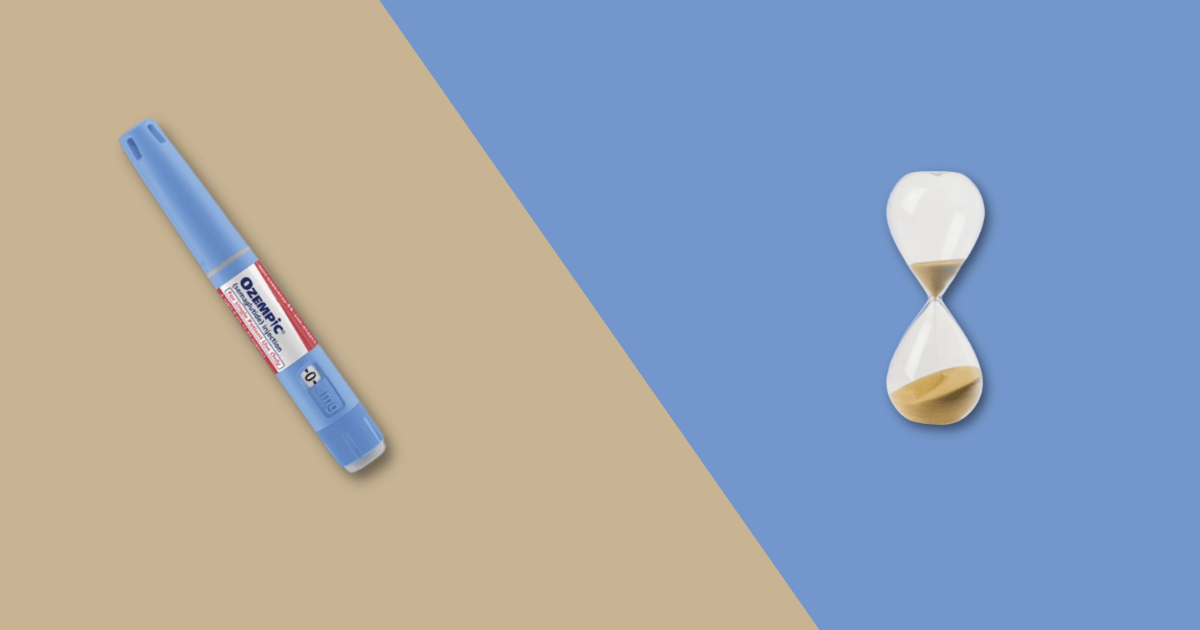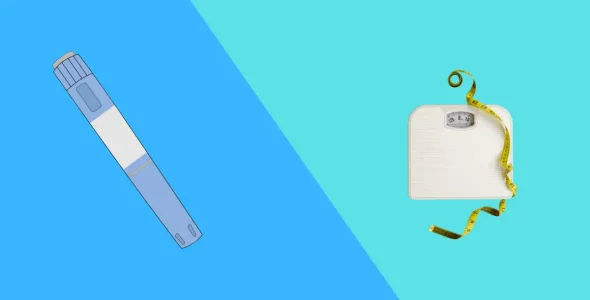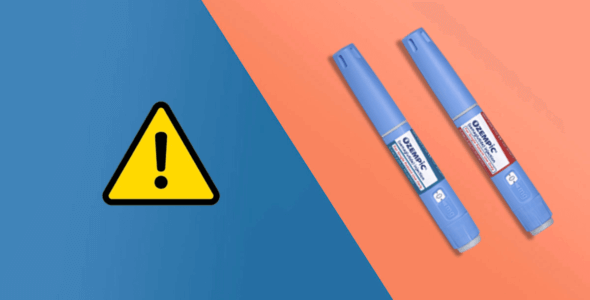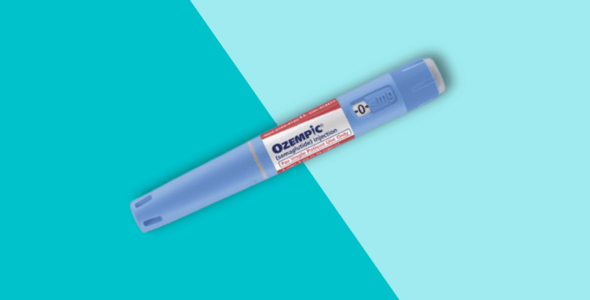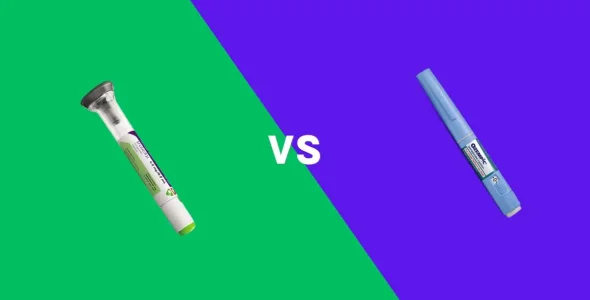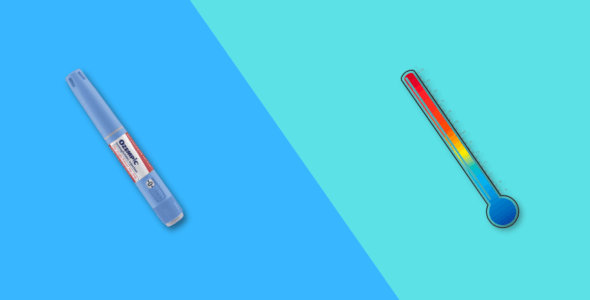How long does Ozempic stay in your system? Ozempic half-life explained
Most people clear semaglutide about 5 weeks after their last dose (up to 5–7 weeks). Keep reading to learn about what that means for side effects, pregnancy, missed doses, and more.
Key highlights
- Ozempic stays in your body for several weeks because the medication has a long half-life of about 7 days. Each week, about half of the medication is cleared, and by week five, only a tiny amount remains. Most people clear it in about 5-7 weeks after their last dose.
- The slow clearance of Ozempic keeps steady levels of the medication in the blood after you administer it, which provides consistent results for a long period.
- Healthcare providers often recommend stopping Ozempic two months before pregnancy, surgery, or when switching medications to give the medication enough time to fully clear from your body.
Manufactured by Novo Nordisk, Ozempic (semaglutide) is a GLP-1 (glucagon-like peptide-1) receptor agonist that helps manage blood glucose levels in patients with type 2 diabetes mellitus and supports weight loss. Healthcare professionals prescribe Ozempic off-label for weight management in overweight and obese individuals.
Semaglutide is the active ingredient in Ozempic, as well as other prescription drugs like Wegovy and Rybelsus. Wegovy is another injectable medication for obesity, while Rybelsus is an oral diabetes medication. All three GLP-1 receptor agonists (glucagon-like peptide-1 receptor agonists) work in similar ways to slow digestion, reduce appetite, and improve glucose control. If you’re taking Ozempic, you may wonder: When does this medication actually leave my body? The timeline matters if you’re planning for pregnancy, preparing for surgery, switching to another treatment, or waiting for side effects to fade.
Since semaglutide is a long-acting medication, it remains in your body for a significantly longer period than most medications. That’s good for steady benefits, but it also explains why the effects of the medication do not stop right away when you miss or stop a dose. Most people clear semaglutide about 5 weeks after their last dose (up to 5–7 weeks).
Continue reading to learn about how long Ozempic stays in your body and what that means when planning to get pregnant, undergoing a surgical procedure, or switching medications.
Understanding semaglutide’s half-life
Semaglutide does not get cleared from the body immediately. Instead, the medication stays in the body for weeks. To understand why, let’s look at the concept of the medication’s “half-life” and how it applies to semaglutide.
What is half-life?
Half-life means the amount of time it takes for half of a medication’s concentration to leave your body. Half-life determines how often you need to take a medication and how long its effects last.
Medications with short half-lives may need to be taken several times a day. In comparison, medications like semaglutide, with a longer half-life, stay for a long time in the body and only need to be taken once weekly. This makes Ozempic and Wegovy convenient for long-term treatment.
You can think of it like this: Every week, half of what’s left in your system is cleared away. After the first week, 50% remains. After the second week, 25% is still there. By the third week, 12.5% of the medication remains in your body, and the cycle continues.
Pharmacologists often use the “five half-lives” rule. After about five cycles, around 97-99% of a drug is gone. Semaglutide is mostly cleared about five weeks after your last dose.
Semaglutide’s half-life
It takes a full week for your body to clear just half of one dose of semaglutide, which forms the basis of its weekly dosing. This weekly schedule is one of the reasons they’re easier to stick with than many other diabetes or weight-loss treatments.
The long half-life also explains why semaglutide doesn’t leave your system right away. The medication remains for 5-7 weeks before it is cleared from the body. If you stop taking Ozempic, the effects of the medication taper off gradually. You may notice the benefits, such as appetite control or low blood sugar levels, fading gradually.
If you’re preparing for pregnancy or need to switch to another medication, your provider will set up the timing to avoid overlap and monitor your symptoms as levels decline.
Why so long?
The half-life of Ozempic allows for convenient once-weekly dosing. Due to the longer half-life of the medication, Ozempic continues to circulate in the body even after treatment stops. The clearance rate of semaglutide depends on how the medication interacts with blood proteins and how the body eliminates it.
Albumin binding
Semaglutide has a special fatty acid side chain in its structure. It helps the medication attach firmly to albumin, which is the most common protein in human blood.
Once semaglutide enters the bloodstream, more than 99% of it becomes bound to albumin. This binding has two important effects. First, it protects semaglutide from being broken down too quickly by enzymes. Second, it slows down how fast the kidneys can filter the medication out of the body.
Slow elimination
Semaglutide stays in the body for longer because the medication is cleared very slowly. Once the medication is in circulation, it is processed and removed at a gradual pace by the body’s natural systems. As most of the medication is bound to albumin, the process of elimination takes much longer.
A smaller factor is absorption at the injection site. After each subcutaneous dose, semaglutide enters the bloodstream slowly over time rather than all at once. This delayed absorption adds to the steady release of the medication.
Reaching “steady state”
When you take Ozempic regularly, the medication keeps building up in your body until it reaches a balance. This balance is called the steady state. At this point:
- The amount of medication you take in with each dose equals the amount your body clears.
- The levels of the medication stay consistent in the blood.
For medications with short half-lives, steady state can happen in just a few days. With semaglutide, the process takes longer because the medication remains in the body for longer. Since its half-life is about seven days, it usually takes 4 to 5 weeks of weekly injections to reach steady state.
Steady state is an important factor that determines when semaglutide starts to work and shows its results in the body. Patients generally have to wait until the medication reaches a steady state and they notice significant changes in their blood sugar levels, appetite suppression, and body weight.
| Timeframe | What Happens |
|---|---|
| First few weeks | Levels of semaglutide start to build in the body. Patients may notice little benefit, but they may be inconsistent. Patients may experience side effects such as nausea and gastrointestinal issues that often improve once the medication reaches a steady state. |
| Around one month | The level of semaglutide in the blood stabilizes. Patients start to notice changes in blood sugar levels, appetite, and body weight. |
| After the steady state | The results of semaglutide become more significant. Patients start to get consistent results. This stability makes semaglutide effective for long-term diabetes and weight management. |
How long until semaglutide is fully cleared from the body?
It takes semaglutide around five half-lives to get almost completely cleared from the body. After 5 half-lives, approximately 97 to 99% of the medication is cleared. Using the five half-lives rule, it roughly takes 35 days (about five weeks) for the medication to be mostly eliminated.
The clearance window can range from 5-7 weeks, depending on the individual, though it usually takes five weeks at the highest dose.
It is important to remember that the effects of semaglutide do not disappear overnight. As the levels of semaglutide drop, the benefits (such as lower blood sugar and reduced appetite) fade gradually. Side effects, like nausea or constipation, also tend to ease over time instead of stopping suddenly.
How the body clears semaglutide:
- First, the body metabolizes semaglutide in the tissues and breaks it down into smaller fragments.
- These byproducts are then removed through natural pathways to excrete waste products, mainly through urine and stool.
- The liver and kidneys play key roles in excretion, but no single organ is responsible for clearance on its own.
The 5x half-life rule
By the time five half-lives have passed, only about 1 to 3 percent remains, which is considered negligible. Using this principle, we can predict how much concentration of the medication is left in the body. According to the 5x half-life rule, the concentration of semaglutide in the blood is as follows:
| Time | Dose Remaining |
|---|---|
| One week | 50% of the dose remains. |
| Two weeks | 25% of the dose remains |
| Three weeks | 12.5% of the dose remains. |
| Four weeks | 6.25% of the dose remains |
| Five weeks | 3.125% of the dose remains |
Clinical studies on semaglutide clearance
In pharmacokinetic studies, semaglutide’s terminal half-life was measured at around 145 to 168 hours, or roughly seven days. This long half-life supports the once-weekly dosing schedule and explains its gradual clearance. It’s binding to albumin also slows down how quickly the kidneys and liver can clear it.
Elimination studies with radiolabeled semaglutide showed that about 75% of the medication and its metabolites were recovered from the body, mostly through urine and stool. The breakdown happens in tissues through normal metabolic pathways, not in a single organ, which is why clearance takes time.
What does this mean for patients?
Detectable medication levels can linger for five to seven weeks after the last injection. Patients who stop semaglutide begin regaining weight and see their cardiometabolic markers shift back. This pattern fits with a medication that clears slowly and whose effects wane step by step.
FDA label
The official U.S. Food and Drug Administration (FDA) label states that semaglutide has an elimination half-life of about one week and can remain in circulation for about five to seven weeks after the last 2.4 mg dose.
Factors that affect elimination time
Several factors can change how long semaglutide stays in your body. Since Ozempic is given as a once-weekly subcutaneous injection, the route of administration affects its absorption and clearance.
Individual metabolism
Your metabolism is how fast your body processes and clears medications. Some people naturally metabolize the medication faster than others. A faster metabolism may clear semaglutide a little sooner. A slower metabolism can make the medication stay in your system longer.
Kidney and liver function
As semaglutide binds strongly to albumin and is cleared slowly, any liver or kidney disease may influence clearance time.
Clinical studies have shown no major differences in clearance time across most patient groups with liver and kidney problems. A clinical trial tested semaglutide in people with mild, moderate, and even severe hepatic impairment. Researchers found that exposure to the medication was similar across all groups compared with people with normal liver function. This means that dose adjustments are not usually needed in patients with impaired liver function.
Another trial tested semaglutide in people with normal kidneys, mild renal impairment, moderate renal impairment, and even severe kidney disease. The results showed that medication levels were only slightly higher in those with reduced kidney function compared to people with normal kidneys.
Importantly, these differences were not large enough to change the half-life or overall clearance timeline of about five to seven weeks. However, dose adjustments are not usually needed in patients with kidney disease. Healthcare providers still recommend close monitoring since dehydration or acute kidney injury can increase the risk of kidney problems.
Semaglutide exposure was nearly identical whether liver function was normal or impaired.
Renal/hepatic function & drug interactions
Most patients do not need dose adjustments. If dehydration or sudden kidney injury occurs, the risks can increase, so it is important to keep your healthcare provider updated. Stay in touch with your prescriber to avoid any risks.
Body weight, age, and sex
Your body size, age, and sex can change how semaglutide is absorbed and used. Research shows that people who weigh less may have slightly higher levels of the medication in their blood, while those who weigh more may have slightly lower levels. People with obesity or type 2 diabetes may also show small differences in exposure compared to leaner participants.
These changes sound important, but they do not make a big difference in how long semaglutide stays in the body. The half-life remains about one week, and the clearance window is still about five to seven weeks for most patients. The FDA’s data confirm that these natural differences do not require dose adjustments and do not alter the overall timeline.
Missed or moved doses
Taking semaglutide on the right schedule helps keep drug levels steady. If you miss a dose, there are simple rules to follow:
- If you remember within four days, take the missed dose as soon as possible and then go back to your normal weekly schedule.
- If more than four days have passed, skip the missed dose and wait to take your next dose on the regular day.
- Never take two doses close together. Doubling up can cause higher exposure and increase side effects.
Dosage and duration of use
The dosage and duration of semaglutide can affect how long the medication stays in your body.
Higher doses mean a larger amount of medicine is present, which may take longer to fully clear than with smaller doses.
Long-term use allows semaglutide to build up to steady levels in the bloodstream. Once you stop, it can take slightly longer to leave your system compared to someone who has only used it for a short time.
Other medications and interactions
Drug interactions are not common, but some are important. Semaglutide is not heavily broken down by liver enzymes, which means it avoids many of the typical drug interactions. However, since the medication slows digestion, it can change how other oral medications are absorbed.
Examples of possible drug interactions of semaglutide include:
| Medication | Effect |
|---|---|
| Warfarin | Slower digestion may alter how blood-thinning drugs like warfarin are absorbed. |
| Oral contraceptives | Delayed absorption may affect how quickly they take effect, although overall effectiveness is not usually reduced. |
| Diabetes medication | Taking medication such as insulin or sulfonylureas can increase the risk of low blood sugar, which may require dose adjustments. |
| Thyroid medication | Oral medications with a narrow therapeutic window, such as medications for thyroid problems, may interact with semaglutide. |
If you are taking these medications, consult your healthcare provider before starting semaglutide to avoid possible drug interactions.
Does semaglutide accumulate in the body?
When you take semaglutide every week, the drug builds up in your system until it reaches a steady level. Doctors call this a steady-state concentration. It usually takes about four to five doses, or one month, for semaglutide to reach this point:
- During the first few weeks, drug levels are still rising.
- Once steady state is reached, the amount coming in with each dose equals the amount being cleared.
- This balance creates consistent effects from week to week.
How long do side effects last after stopping?
Semaglutide leaves the body slowly, which means side effects also fade gradually instead of disappearing overnight. Common side effects of semaglutide include:
- Digestive symptoms such as nausea, constipation, or diarrhea often improve within a couple of weeks after the last dose.
- Fatigue or headaches may linger for several days to weeks, depending on how sensitive you are to the medication.
- Appetite and “food noise” usually return as the drug level declines, often within one to two months.
- Blood sugar levels in people with type 2 diabetes tend to drift back toward baseline as the drug clears, which may require adjusting other medications.
Can you speed up semaglutide clearance?
Many patients wonder if there is a way to “flush” semaglutide out of their system more quickly. The simple answer is no. There are no quick fixes. Products or remedies that claim to accelerate clearance are not supported by science, such as:
- Detox teas and cleanses do not affect semaglutide levels.
- Drinking large amounts of water may keep you hydrated, but it does not make the medication leave faster.
- Supplements marketed to “boost metabolism” have no proven effect on semaglutide clearance.
What can you do to speed up semaglutide clearance?
Although you cannot shorten the timeline, you can support your overall health while your body clears the medication. Here are a few tips:
- Stay hydrated to help your kidneys and digestion function normally.
- Eat balanced meals and avoid heavy alcohol use to support your liver.
- Light activity or exercise can keep your metabolism steady and help you feel better overall.
If too much semaglutide is taken, it is important to consult with your healthcare provider to seek medical advice. As the medication lasts so long, supportive care and monitoring are needed until levels come down naturally.
Planning discontinuity for specific scenarios
Although semaglutide is intended to be used on a long-term basis, you may need to pause the medication in a few situations, such as pregnancy, surgeries, or any procedures involving anesthesia. The following are general guidelines for common situations when you need to discontinue semaglutide, along with timeframes:
I’m stopping for pregnancy
Semaglutide should not be used during pregnancy. The FDA label advises stopping at least two months, or eight weeks, before trying to conceive so the medication has time to fully clear from the body.
This recommendation is based on the lack of human safety data and concerns about potential risks to a developing fetus. If you are planning a pregnancy, work closely with your OBGYN and endocrinologist to safely discontinue the medication.
I’m switching medications
When switching from semaglutide to another diabetes or weight management treatment, your provider may recommend a washout schedule. This prevents sudden gaps in treatment and helps manage blood sugar control and regulate appetite, which can rebound as semaglutide levels decline.
I took too much
Taking more semaglutide than the prescribed doses is a medical emergency. As Ozempic has a longer half-life, symptoms of overdose can persist for days or even weeks. Patients may need prolonged monitoring and supportive care. If you think you have taken too much, seek emergency help immediately or call Poison Help for guidance.
I’m stopping due to side effects
Sometimes, the side effects of Ozempic are too severe to continue treatment. If nausea, fatigue, or other mild symptoms become unmanageable even with lifestyle changes, your provider may recommend stopping. In rare cases, serious side effects such as pancreatitis (inflammation of the pancreas), gallbladder problems, severe abdominal pain, or signs of an allergic reaction can also require discontinuation. Your clinician can suggest strategies to ease these side effects, guide discontinuation, and discuss safer alternatives according to your needs.
Ozempic has a boxed warning for thyroid cancer and MEN-2 syndrome, as mentioned in the FDA’s label. If you develop any type of thyroid tumor, immediately stop taking semaglutide.
I’ll be having surgery
Many healthcare providers recommend stopping semaglutide at least one week before surgery, sometimes longer, depending on the type of procedure. Since semaglutide delays stomach emptying, keeping it in your system raises the risk of aspiration while under anesthesia. Pausing the medication before surgery allows your digestive system to reset, which in turn lowers this risk.
“Cold turkey” vs. tapering
Stopping semaglutide suddenly is not considered dangerous. The medication does not cause withdrawal symptoms in the way some other medications do. When you stop taking semaglutide, the effects do not disappear right away because the medication stays in the body for weeks, and changes happen gradually as levels drop. However, patients often notice the return of their original conditions, such as increased appetite, weight gain, or higher blood sugar levels.
In contrast, tapering involves gradually reducing the dose over time, rather than stopping it suddenly. Tapering can make the transition more gradual, give your body more time to adjust, and help you focus on lifestyle changes to support weight and blood sugar control. However, this proves to be more complex and requires careful dose adjustment. It also does not prevent weight regain or an increase in blood sugar level.
Consult with your healthcare provider if you want to stop the medications. They will guide you on the most appropriate discontinuation plan.
What happens after you stop semaglutide?
When you stop taking semaglutide, the effects do not disappear right away because the medication stays in the body for weeks, and changes happen gradually as levels drop.
Gradual return of original conditions
Appetite control is usually the first change patients notice. The calming effect on “food noise” fades, and hunger slowly comes back. This can lead to eating more calories. Studies show that many people regain about two-thirds of the weight they lost within a year of stopping. This is why obesity is considered a chronic condition that often requires ongoing management.
For people with type 2 diabetes, blood sugar levels usually rise back toward pre-treatment levels. Other medicines may need to be adjusted or restarted. Cardiometabolic benefits, such as better blood pressure and cholesterol, can also fade over time once treatment is stopped
Lingering side effects
Side effects do not vanish immediately. Semaglutide has a long half-life; this is why side effects like nausea, constipation, diarrhea, fatigue, or headaches may last for days to weeks. These usually improve as the medication continues to clear from the body.
Withdrawal symptoms
Semaglutide does not cause withdrawal symptoms in the medical sense. What patients sometimes describe as withdrawal is really your body readjusting. Hunger returns, weight begins to creep back, and blood sugar levels rise again. These changes reflect the underlying condition rather than dependence on the medicine.
FAQs
Will semaglutide show up on a drug test?
No, semaglutide does usually show up on drug tests. Standard drug tests do not check for semaglutide. These tests screen for substances of abuse, not prescription medications like Ozempic, Wegovy, Mounjaro, or Zepbound.
Can I switch to another GLP-1 agonist faster?
No, you can not switch to another GLP-1 medication faster. Your provider may recommend a washout or overlap plan if you are switching. Timing depends on the new medication and your health goals.
How long until weight regain after stopping?
Weight often starts to return within months. Studies show many patients regain about two-thirds of the weight they lost within a year of stopping semaglutide.
How long does semaglutide stay in your system after the last dose?
Most of the semaglutide in your body clears in about five weeks, but it can take up to seven weeks in some people after the last dose.
Is the timeline different for Ozempic vs. Wegovy?
Yes, the timeline for clearance from the body is almost the same, as both Ozempic and Wegovy contain semaglutide. However, the doses and indications of these medications are different.
Can you get semaglutide out faster?
No, you can not clear semaglutide faster from your body. The body clears semaglutide gradually on its own. Detoxes, extra water, or special foods do not speed up clearance.
What if I miss a weekly dose?
If you remember within four days or 96 hours, take your missed dose of Ozempic as soon as possible. If more than four days have passed, skip it and take your next dose on the regular day. If you have missed more than two doses, contact your healthcare provider for dose adjustments.
Why do some effects linger?
Semaglutide has a long half-life. This means both benefits and side effects may last for weeks after your last injection.
How far ahead should I stop before pregnancy?
The FDA recommends stopping at least two months before trying to conceive. This ensures the medication is fully cleared from the body before you conceive.
Does kidney or liver disease change the timeline?
Most studies show no major change in clearance, but patients with kidney or liver problems should be monitored closely to avoid the risk of any side effects.
Conclusion: Understanding semaglutide’s half-life so you can plan accordingly
Semaglutide stays in your system longer than most medications. The medication has a half-life of about one week, and it usually takes five weeks or sometimes up to seven before the drug is completely cleared from the body.
The effects do not stop suddenly but wear off gradually, which means benefits like appetite control and blood sugar stability fade gradually over time, and side effects such as nausea or fatigue may also take some time to settle.
A personalized treatment plan is essential since each patient responds differently. If you are preparing yourself for pregnancy, scheduling surgery, or thinking about switching treatments, it is important to work with your healthcare provider. They can help you make changes safely and manage any symptoms as semaglutide leaves your body.
By understanding the timeline, you can set realistic expectations, avoid side effects, and keep your long-term health goals on track.
